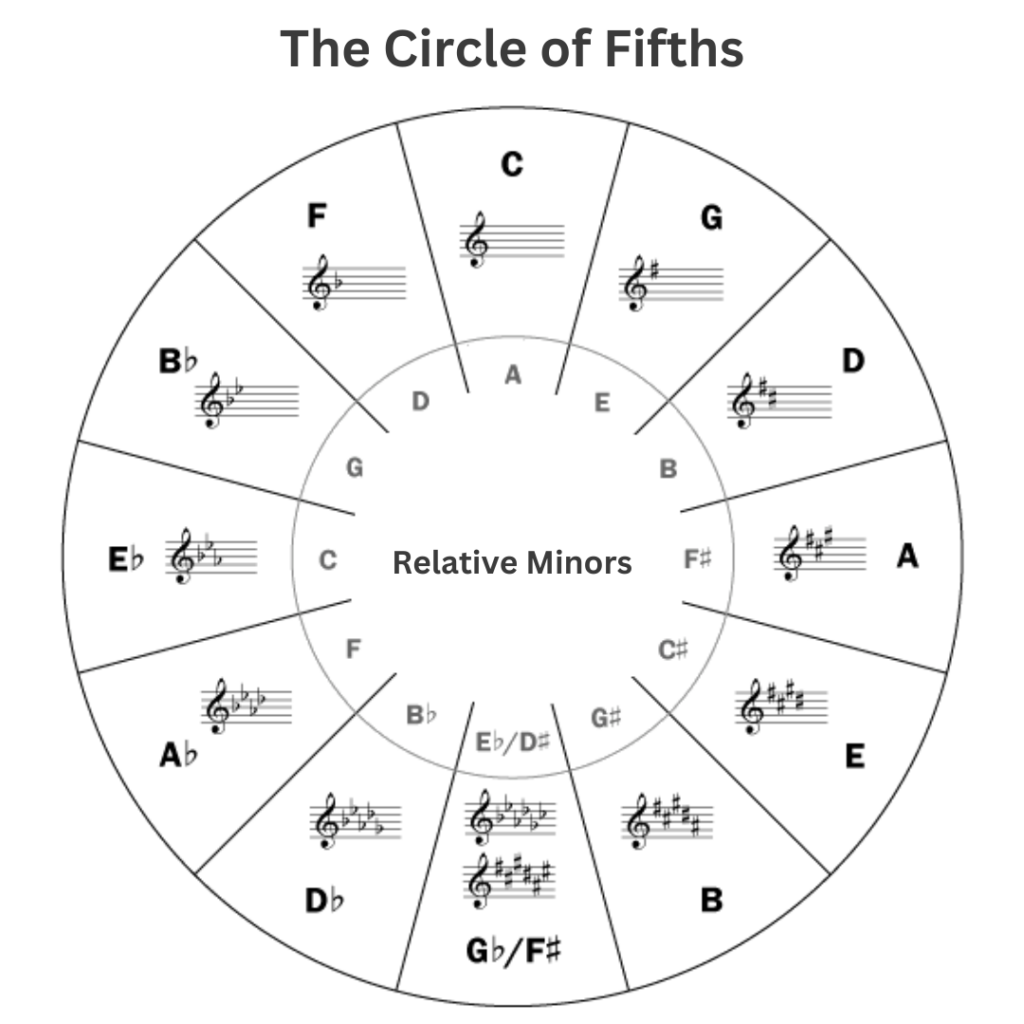Using the Circle of Fifths to Understand Harmonic Relationships
Have you ever wondered how musicians effortlessly transition between keys or write harmonically interesting compositions? Enter the Circle of Fifths, a wonderful tool that explains the relationships between keys and harmonic progressions.
Whether you’re strumming a guitar and penning lyrics to your next song or trying to transcribe a Miles Davis solo, this music theory lesson about the Circle of Fifths will improve your ability to understand and express musical ideas.
Understanding the Circle of Fifths
At its core, the Circle of Fifths is a visual representation of the relationships between the 12 tones of the chromatic scale, organized in a circular diagram representing all diatonic keys and their corresponding relative minor keys. Its origins can be traced back centuries, with roots in the works of music theorists like Johann David Heinichen and Nikolay Diletsky.
Imagine a clock where each hour represents a musical key. Starting at 12 o’clock with the key of C major, move clockwise, and you’ll encounter each successive key signature, each a fifth higher than the previous one. Hence, the name “Circle of Fifths.”
This movement illustrates the relationship between adjacent keys, making it easier to understand chord progressions and modulations.

But wait, there’s more! Flip the script and move counterclockwise, and you’ll uncover the Circle of Fourths, a favorite among jazz musicians because it helps with memorizing the ii-V-I progression in every key.
For example, in the key of Bb the ii-V-I progression is:
Cm7 (ii) – F7 (V) – Bbmaj7 (I)
The reason for this being the ii-V-I progression in Bb can be explained using diatonic harmony to examine the notes of the Bb major scale:
Bb (I) – C (ii) – D (iii) – Eb (IV) – F (V) – G (vi) – A (vii)
Following the Circle of Fifths counterclockwise (right to left) reads as C – F – Bb. For more advanced players, this can be an effective means of practicing the ii-V-I progression in all keys.
Key Signatures and Major Keys
Key signatures, those little symbols at the beginning of sheet music, hold the key (pun intended) to unlock the Circle of Fifths. Each key signature corresponds to a specific major key, and their placement on the circle follows a logical pattern.
Let’s say you want to figure out the key signature for G major. Start at C major (12 o’clock), move clockwise to the key of G major (one-fifth up), and voilà! You’ll find one sharp in the key signature, indicating F-sharp. It’s like magic but with music theory!
Here’s a list of all 12 major keys, along with the number of sharps or flats they contain and what those sharps and flats are:
Sharp Keys
- C Major: 0 sharps or flats
- G Major: 1 sharp (F♯)
- D Major: 2 sharps (F♯, C♯)
- A Major: 3 sharps (F♯, C♯, G♯)
- E Major: 4 sharps (F♯, C♯, G♯, D♯)
- B Major: 5 sharps (F♯, C♯, G♯, D♯, A♯)
- F♯ Major: 6 sharps (F♯, C♯, G♯, D♯, A♯, E♯)
- C♯ Major: 7 sharps (F♯, C♯, G♯, D♯, A♯, E♯, B♯)
Flat Keys
- C Major: 0 sharps or flats
- F Major: 1 flat (B♭)
- B♭ Major: 2 flats (B♭, E♭)
- E♭ Major: 3 flats (B♭, E♭, A♭)
- A♭ Major: 4 flats (B♭, E♭, A♭, D♭)
- D♭ Major: 5 flats (B♭, E♭, A♭, D♭, G♭)
- G♭ Major: 6 flats (B♭, E♭, A♭, D♭, G♭, C♭)
- C♭ Major: 7 flats (B♭, E♭, A♭, D♭, G♭, C♭, F♭)
To learn more, check out our in-depth article about Major Scale Harmony and Musical Modes. Also, check out this video from Green Hills Guitar Studio instructor, Sam Farkas, for some advice on how to practice scales.
Check out our article about moveable major scale patterns to start applying the Circle of Fifths to your scale practice routine.
A Note About Enharmonic Tones
Enharmonic tones are musical notes that sound the same pitch but are spelled differently. In the context of the Circle of Fifths, understanding enharmonic tones is essential for navigating key relationships accurately.
For example, the key of G♭ major and the key of F♯ major contain the same pitches but are spelled differently due to enharmonic equivalence. While G♭ major has six flats (B♭, E♭, A♭, D♭, G♭, C♭), F♯ major has six sharps (F♯, C♯, G♯, D♯, A♯, E♯).
Enharmonic tones may appear differently on sheet music, but they represent the same pitches on a musical instrument.
Understanding enharmonic equivalents allows musicians to interpret key signatures accurately and navigate the Circle of Fifths effectively, ensuring seamless transitions between keys in compositions and performances.
Key Signatures and Relative Minor Keys
Now, let’s delve into the world of relative minor keys, the yin to major keys’ yang. Every major key has a relative minor key that shares the same key signature. How do you find it? Look no further than the Circle of Fifths.
For instance, the relative minor of C major is A minor. Just locate C major on the circle, and its relative minor is right next door. This relationship opens up a world of possibilities for creating emotive chord progressions and adding depth to your compositions.
Speaking of chord progressions, the Circle of Fifths provides a roadmap for crafting harmonically satisfying sequences. Whether you’re strumming a simple I-IV-V progression or experimenting with more complex patterns, the circle guides you every step of the way.
Look at the Circle of Fifths diagram again and pay attention to the inner circle to learn the relative minor keys.

Here are the relative minor keys corresponding to each major key, along with the number of sharps or flats they contain and what those sharps and flats are:
Sharp Keys (relative minor)
- A Minor (relative to C Major): 0 sharps or flats
- E Minor (relative to G Major): 1 sharp (F♯)
- B Minor (relative to D Major): 2 sharps (F♯, C♯)
- F♯ Minor (relative to A Major): 3 sharps (F♯, C♯, G♯)
- C♯ Minor (relative to E Major): 4 sharps (F♯, C♯, G♯, D♯)
- G♯ Minor (relative to B Major): 5 sharps (F♯, C♯, G♯, D♯, A♯)
- D♯ Minor (relative to F♯ Major): 6 sharps (F♯, C♯, G♯, D♯, A♯, E♯)
- A♯ Minor (relative to C♯ Major): 7 sharps (F♯, C♯, G♯, D♯, A♯, E♯, B♯)
Flat Keys (relative minor)
- A Minor (relative to C Major): 0 sharps or flats
- D Minor (relative to F Major): 1 flat (B♭)
- G Minor (relative to B♭ Major): 2 flats (B♭, E♭)
- C Minor (relative to E♭ Major): 3 flats (B♭, E♭, A♭)
- F Minor (relative to A♭ Major): 4 flats (B♭, E♭, A♭, D♭)
- B♭ Minor (relative to D♭ Major): 5 flats (B♭, E♭, A♭, D♭, G♭)
- E♭ Minor (relative to G♭ Major): 6 flats (B♭, E♭, A♭, D♭, G♭, C♭)
- A♭ Minor (relative to C♭ Major): 7 flats (B♭, E♭, A♭, D♭, G♭, C♭, F♭)
These relative minor keys share the same key signatures as their corresponding major keys, making it easy to identify them on the Circle of Fifths and understand their harmonic relationships.
Hungry to learn more about diatonic harmony? Check out this video from Sam Farkas:
Modulation and Key Changes
Ever marveled at how a song seamlessly transitions between keys without missing a beat? That’s modulation in action, and the Circle of Fifths is your trusty navigator.
What is Modulation?
Modulation is the process of transitioning from one key to another within a piece of music. It can be used to create a sense of progression, change, or contrast, adding depth and interest to the music.
Types of Modulation
- Direct Modulation: In direct modulation, the music shifts abruptly from one key to another without any transitional elements. This type of modulation is often used for dramatic effect and can create a sudden change in mood or intensity.
- Pivot Chord Modulation: Pivot chord modulation involves using a chord that belongs to both the current key and the key to which the music is modulating. This pivot chord acts as a bridge between the two keys, facilitating a smooth transition.
- Common-Tone Modulation: Common-tone modulation occurs when a single note or chord is sustained between two keys, serving as a common element that connects them. This type of modulation creates a sense of continuity and cohesion in the music.
Role of the Circle of Fifths
The Circle of Fifths serves as a valuable tool for planning and executing modulations. By showing the relationships between keys, it helps musicians identify potential key changes and select appropriate pivot chords or common tones.
Examples of Impactful Modulation
Listen to classics like “I Will Always Love You” (Whitney Houston version) or “Bohemian Rhapsody” by Queen, and you’ll hear how modulation adds depth and intrigue to the music.
- In “I Will Always Love You,” the modulation from the key of A major to the key of B major in the final chorus enhances the emotional climax of the song.
- Similarly, in “Bohemian Rhapsody,” the modulation from the key of B♭ major to the key of A♭ major during the operatic section adds drama and intensity to the music.
By incorporating modulation into your compositions or performances, you can add depth and complexity to your music, keeping listeners engaged and intrigued.
Practical Application for Guitarists and Songwriters
Now, let’s dive into practical application. Imagine the Circle of Fifths as your musical treasure map, waiting to be explored by adventurous guitarists and songwriters like you.
Here are some tips to get you started:
1. Create Tension and Release
Begin by selecting a chord progression from the Circle of Fifths. Let’s say you start in the key of C major (no sharps or flats) and move clockwise to its dominant, G major.
Experiment with building a chord progression that moves from the tonic chord (C major) to the dominant chord (G major), creating a sense of tension.
Then, add another chord from the key of G major, perhaps the submediant chord (E minor), to prolong the tension before resolving back to the tonic chord (C major). This tension-release dynamic adds intrigue and emotion to your music.
2. Mix Things Up
Don’t be afraid to mix and match chords from neighboring keys to spice up your compositions. For example, try incorporating the subdominant chord (F major) from the key of C major into your progression before resolving back to the tonic.
Then, introduce a borrowed chord from a distant key, such as the dominant chord (D major) from the key of G major, to add an unexpected twist. This harmonic complexity can captivate listeners and elevate your music to new heights.
3. Discover New Harmonic Landscapes
Venture into uncharted territory on the Circle of Fifths by exploring key relationships that you haven’t yet encountered. Experiment with moving counterclockwise to find surprising connections between keys. Who knows? You might stumble upon a harmonic gem that inspires your next musical masterpiece.
The Coda
In conclusion, the Circle of Fifths is more than just a diagram—it’s a gateway to musical enlightenment. Whether you’re a seasoned musician or a budding songwriter, embracing the circle can transform your musical journey.
So, next time you pick up your guitar or sit down at the piano, remember the power of the Circle of Fifths. Let it guide you through the intricate tapestry of key relationships and harmonic structures, enriching your music with depth and nuance.
Embrace the circle, and watch your musical horizons expand beyond imagination. Happy harmonizing!
Interested in Taking Lessons?
Interested in diving deeper into guitar or songwriting? Contact Green Hills Guitar Studios today for personalized lessons in Nashville or online.
Whether you’re a beginner looking to master the basics or an experienced musician seeking to refine your skills, our expert instructors are here to help you reach your musical goals.
Unlock your full potential and take your music to the next level with Green Hills Guitar Studios.






